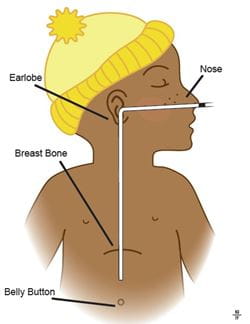 Supplies You Will Need
Supplies You Will Need
- NG feeding tube
- Cup of water
- 5 ml syringe
- Permanent marker
- Tape, cut into strips, and/or clear dressing
- Gauze or washcloth
- Skin prep (if needed)
Preparing for Tube Placement
1. Wash your hands with soap and water.
2. Gather all the supplies.
3. Select which side of the nose to use. If this is a first insertion, consider using the side with the better airflow. Then alternate between the two sides of the nose.
4. Wipe skin around cheek and nose clean and allow to dry completely.
5. Apply skin prep to cheek if appropriate.
6. Apply skin protective dressing, such as extra thin duoderm.
7. Position the patient: an infant can be held, secured in an infant carrier, or swaddled. An older child or adult may lie down or sit up as able Inserting the Tube
8. Some NG feeding tubes have a stylet, which is a thin wire that is in the NG tube that helps during placement. If your tube has a stylet:
- Pull back slightly on the stylet before placing the tube to make sure it moves freely. Then push the stylet back into place.
9. If there are two ports on the end of the feeding tube, close the cover on the port that does not have the stylet.
10. Measure from the tip of the nose to the earlobe on the side of the face you are inserting the tube. Then measure from the earlobe to the end of the breastbone where the ribs come together. Then measure from the end of the breastbone to halfway between the breastbone and the belly button. This point is your length. Mark this point with a permanent marker.
11. Dip the end of the feeding tube in water to make it slippery.
- Do not use gels or Vaseline due to the danger of the getting these things into the lungs and / or clogging the feeding tube.
12. Insert the tube through the nostril until you reach the marked point.
- Insert gently directing the tube along the floor of the nose, avoiding poking straight up. If you meet resistance, pull back a bit and try redirecting downward toward the ear.
- Slightly bend child’s head forward when the feeding tube is at the curve of the nose and throat. Avoid bending the neck backwards which opens the airway.
- Older children may take sips of water; infants may suck on a pacifier, if desired.
- Proceed with moving the tube downward as your child swallows.
- To avoid injury, never push against resistance when placing the NG tube.
- Gagging is normal while the tube is being placed.
13. However if your child is choking, coughing or having trouble breathing, pull the tube out immediately and let your child rest before trying again.
14. Once you have the feeding tube in place, hold the tube between your fingers and remove the stylet.
- Save the stylet in a plastic bag. You will need to re-insert the stylet when you reinsert the NG tube.
15. Connect the syringe to the feeding port and pull back to get 1-2 ml of stomach contents.
- When you get stomach contents, remove the syringe, discard the stomach contents and tape the feeding tube in place.
- If you are not able to remove stomach contents, remove the syringe, close cover on the port and place your child on their left side for 10 minutes. After 10 minutes, connect syringe and pull back to get stomach contents.
- If you are still not able to get stomach contents, remove the feeding tube, reinsert stylet into feeding tube, measure the feeding tube again and change mark, if needed. Then insert the feeding tube and check for stomach contents again.
- If you are still unable to pull back stomach contents, call your health care provider.
16. Do not start a feeding or give a medication until you have confirmed that the feeding tube is in the stomach.
Removing the Feeding Tube
1. Remove the tape that is holding the tube in place.
2. Pinch the feeding tube and pull the tube out.
- Pinching the tube prevents anything leaking out of the tube while you are removing it.
3. Rinse the feeding tube with warm water using a syringe and check for any holes or tears.
Things to Remember
- Always wash your hands before and after handling the feeding tube.
- Always remove the stylet from the feeding tube once it has been inserted.
- Never put the stylet back into the feeding tube while the tube is in your child.
- Always save the stylet to the feeding tube. It will be necessary to have the stylet to reinsert the tube.
- Do not use the feeding tube again if:
- There are any holes or tears in the tube
- The tube is stretched out and the stylet no longer fits into the tube.
- The tube is due to be changed (change monthly or sooner as recommended)
- The tube is difficult to flush or pass formula through



